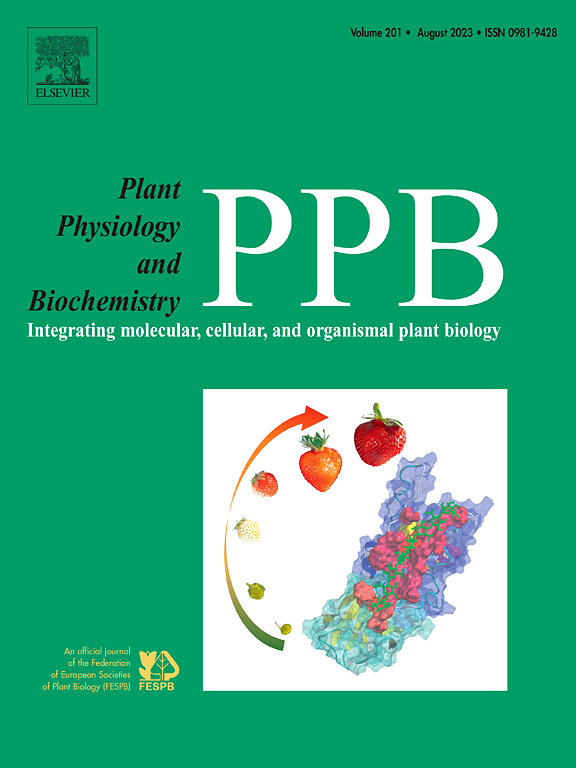Exogenous Hydrogen sulfide attenuates cadmium toxicity to Chrysanthemum (Chrysanthemum indicum) by modulating glutathione synthesis and cadmium adsorption capacity in the cell wall
IF 6.1
2区 生物学
Q1 PLANT SCIENCES
引用次数: 0
Abstract
Soil cadmium (Cd) contamination leads to plant toxicity and poses a risk to human health both directly and indirectly through the food chain. Hydrogen sulfide (H2S), a novel gaseous signaling molecule, has been shown to enhance plant tolerance to various abiotic stresses. In this study, the potential of H2S in mitigating Cd toxicity in chrysanthemum (Chrysanthemum indicum) was investigated through physiological, biochemical and transcriptomic analyses. Results showed that the application of exogenous H2S resulted Cd accumulation in the roots by 21.15%, while reducing Cd in the aboveground parts by 13.21%. It was further found that H2S increased the pectin and hemicellulose content by 50.09% and 49.79%, respectively, through the regulation of cell wall polysaccharide synthesis-related genes, leading to changes in root functional group content and cell wall adsorption capacity for cadmium ions (Cd2+). Additionally, H2S also promoted the synthesis of GSH and PCs by regulating the expression of genes related to sulfur metabolism, chelating free Cd2+ in the cytoplasm, and reducing their harmful effects on the organelles. It was also found that exogenous H2S may have regulated the expression of transporter proteins by modulating the expression of transcription factors (MYB, AP2/ERF, and WRKY), thereby affecting the uptake, transport, and accumulation of Cd2+. In conclusion, exogenous H2S reduced the free Cd2+ content in the cytoplasm by promoting the adsorption of Cd2+ in the root cell walls and facilitating the synthesis of GSH and PCs in the cells, which in turn alleviated the toxic effects of Cd2+ on chrysanthemum.
外源硫化氢通过调节菊花谷胱甘肽合成和细胞壁对镉的吸附能力来减轻镉对菊花的毒性
土壤镉污染导致植物毒性,并通过食物链直接和间接地对人类健康构成风险。硫化氢(H2S)是一种新型的气体信号分子,可以增强植物对各种非生物胁迫的耐受性。本研究通过生理生化和转录组学分析,探讨了H2S对菊花(chrysanthemum indicum) Cd毒性的抑制作用。结果表明,施用外源H2S可使根部Cd累积量提高21.15%,地上部Cd累积量降低13.21%。进一步发现,H2S通过调控细胞壁多糖合成相关基因,使果胶和半纤维素含量分别提高了50.09%和49.79%,从而改变了根官能团含量和细胞壁对镉离子(Cd2+)的吸附能力。H2S还通过调节硫代谢相关基因的表达,螯合胞质中游离Cd2+,减少其对细胞器的有害作用,促进GSH和PCs的合成。研究还发现,外源H2S可能通过调节转录因子(MYB、AP2/ERF和WRKY)的表达来调节转运蛋白的表达,从而影响Cd2+的摄取、运输和积累。综上所述,外源H2S通过促进根细胞壁对Cd2+的吸附,促进细胞内GSH和pc的合成,从而降低了细胞质中游离Cd2+的含量,从而减轻了Cd2+对菊花的毒性作用。
本文章由计算机程序翻译,如有差异,请以英文原文为准。
求助全文
约1分钟内获得全文
求助全文
来源期刊
CiteScore
11.10
自引率
3.10%
发文量
410
审稿时长
33 days
期刊介绍:
Plant Physiology and Biochemistry publishes original theoretical, experimental and technical contributions in the various fields of plant physiology (biochemistry, physiology, structure, genetics, plant-microbe interactions, etc.) at diverse levels of integration (molecular, subcellular, cellular, organ, whole plant, environmental). Opinions expressed in the journal are the sole responsibility of the authors and publication does not imply the editors'' agreement.
Manuscripts describing molecular-genetic and/or gene expression data that are not integrated with biochemical analysis and/or actual measurements of plant physiological processes are not suitable for PPB. Also "Omics" studies (transcriptomics, proteomics, metabolomics, etc.) reporting descriptive analysis without an element of functional validation assays, will not be considered. Similarly, applied agronomic or phytochemical studies that generate no new, fundamental insights in plant physiological and/or biochemical processes are not suitable for publication in PPB.
Plant Physiology and Biochemistry publishes several types of articles: Reviews, Papers and Short Papers. Articles for Reviews are either invited by the editor or proposed by the authors for the editor''s prior agreement. Reviews should not exceed 40 typewritten pages and Short Papers no more than approximately 8 typewritten pages. The fundamental character of Plant Physiology and Biochemistry remains that of a journal for original results.

 求助内容:
求助内容: 应助结果提醒方式:
应助结果提醒方式:


